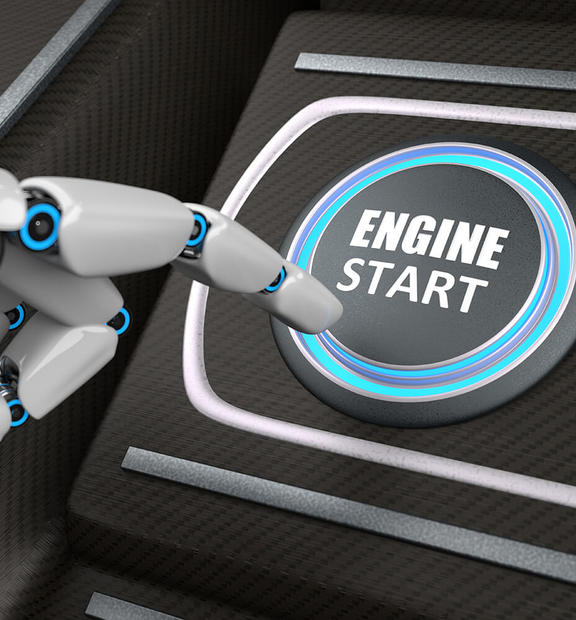We are entering an exciting age – the age of the internet of things (IoT). Everything from appliances to door locks to lights will be able to talk to everything else. By 2020, the most connected application will be the connected car, according to an IBM infographic. Connected car IoT ranks among the most exciting opportunities among all this connectedness.
And there’s a serious amount of connectedness. In 2012, eight billion to 10 billion devices were connected to the Internet, according to High Mobility Magazine’s “A Beginner’s Guide To The Internet Of Things, Connected Cars And The Future Of Mobility” article. By 2020, there will be 24 billion – four devices per person.
Cars are so much a part of everyone’s lives that the potential for enhancement is huge. We’re seeing already that Siri and Alexa can talk to us in the car just as if we were at home – bringing along all our preferences and capturing our habits so they can serve us better (aka sell us things). In parallel, an entire ecosystem is forming around creating applications and services to enhance (and monetize) the connected car space.
But the potential of the connected car – otherwise known as the smart car – goes much deeper than services and monetization. The auto industry is undergoing a transformation. The car itself, the way it’s supported and the features it offers are becoming connected and therefore enhanced.
As a result, effective monitoring of the data output from connected cars is going to become increasingly important, especially with connected cars expected to produce 350 MB of data per second by 2020, according to the IBM infographic.
Let’s explore three major reasons why connectivity monitoring will be an essential – and valuable – piece of the connected car IoT puzzle. But first, let’s look at why connected cars are so appealing.
The promise of connected car IoT
The car of the (near) future will be a mobile software platform – covered in metal, plastic and leather bits and sitting on four wheels.
Engineering simulation company ANSYS calls the modern car “the world’s most technologically advanced consumer product and a key part of the internet of things.” The promise of connected cars can be divided roughly into two communications technologies with distinct benefits for consumers:
- Vehicle-to-infrastructure (V2I): Stream diagnostic data to an auto service center, and help locate and reserve vacant parking spots
- Vehicle-to-vehicle (V2V): Powered by high-speed, high-bandwidth in-vehicle networks, cameras and radar, V2V will let cars avoid collisions, streamline traffic and become autonomous in just a few years.
Automated driver assistance (ADAS) and the self-driving car (AV) further leverage connectivity to make the connected car increasingly compelling.
Connected car IoT represents an upgrade from the traditional car and a “revolutionary way” to drive and stay connected simultaneously, according to KaaIoT Technologies, LLC, which developed an enterprise-grade platform that enables cloud capabilities for connected devices. The automotive industry, namely original equipment manufacturers (OEMs), will pay a key role.
“By offering a dazzling variety of infotainment services and connected car applications for drivers, the automotive sector has the potential to become a prominent IoT champion and pump up adoption of IoT cloud services adoption among car owners and walkers alike,” according to the company.
The importance of connectivity monitoring
In much of the world, cellular networks with 4G LTE, and soon 5G, can provide comprehensive connected car IOT connectivity. But most of the time isn’t all of the time. Things can and will go wrong (usually at the most inconvenient of times) – and that’s where the need for visibility and monitoring comes in.
How do connected IoT “things” work? The requirements for connectivity are simple:
- A wireless network (with wireless coverage)
- A wireless device in the “thing” that’s connected to and through that network
For cars, there’s also a wireless subscription that usually needs to work in multiple countries – basically on different networks wherever one chooses to drive.
All of this needs to be monitored – and the best place to do this is from the connected car’s perspective – in the car.
Monitoring delivers peace of mind across our lives. Security systems monitor our property while we are not there and protect us when we are. Smoke and fire alarms monitor the air and for fire – keeping us from harm. In the same way, connectivity in the connected car will be monitored to protect us and the connected car IoT functionality we will come to rely on.
Software in the wireless device in each car monitors wireless network interaction and connectivity performance, providing auto OEMs with early warning of issues with either the TCU the car’s wireless device or the network connection.
3 major reasons to monitor connectivity in connected cars
The ownership lifetime will be extended through auto OEMs’ visibility into performance and their ability to address issues and offer new services “over the air.”
Effective connected car monitoring offers three major benefits:
- #1 - Catch connectivity issues early: Detecting issues earlier allows them to be fixed faster, reducing the impact on customer satisfaction and service quality
- #2 – Lower warranty costs: Issue detection also helps decrease warranty costs and the prospect of recalls, saving the auto OEMs money
- #3 – Speed up resolution: Monitoring enables Auto companies to detect cellular network and subscription issues and determine quickly whether the problem is a network or a car issue, helping assign responsibility and speed up resolution.
Check out our 5G page to learn more about how our planning and testing solutions are helping launch the future of connectivity.










